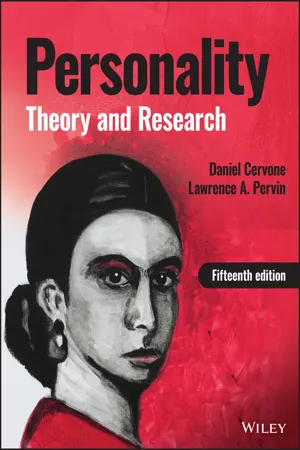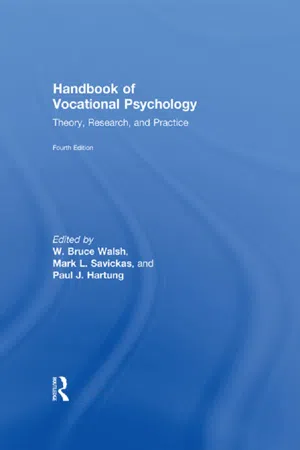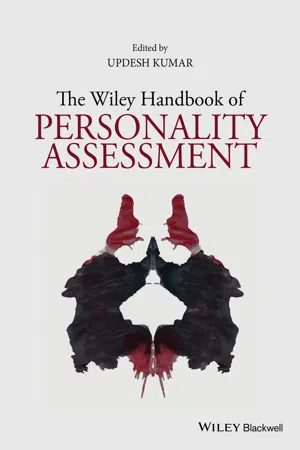Business
Big Five Personality Traits
The Big Five Personality Traits, also known as the Five Factor Model, are a set of five broad dimensions that are used to describe human personality. These traits include openness, conscientiousness, extraversion, agreeableness, and neuroticism. In a business context, understanding these traits can help in hiring decisions, team building, and leadership development.
Written by Perlego with AI-assistance
Related key terms
1 of 5
12 Key excerpts on "Big Five Personality Traits"
- eBook - PDF
- Jerry Burger, , , , Burger(Authors)
- 2014(Publication Date)
- Cengage Learning EMEA(Publisher)
Rather, they let the data do the talking. Once researchers saw which traits clustered with one another, they had to come up with descriptive terms for the five dimensions. Although different researchers sometimes use different names, the most commonly used terms are Neuroticism, Extraversion, Open-ness, Agreeableness, and Conscientiousness. Alert students have recognized that the beginning letters of the five labels cover the OCEAN of human personality. The Neuroticism dimension places people along a continuum according to their emotional stability and personal adjustment. People who frequently experience emotional distress and wide swings in emotions will score high on measures of Neuroticism. People high in Neuroticism tend to become more upset over daily stressors than those low on this dimension and are more vul-nerable to bouts of anxiety and depression (Gunthert, Cohen, & Armeli, 1999; Kotov, Gamez, Schmidt, & Watson, 2010; Lahey, 2009). Although TABLE 7.1 The Big Five Personality Factors Factor Characteristics Neuroticism Worried versus calm Insecure versus secure Self-pitying versus self-satisfied Extraversion Sociable versus retiring Fun-loving versus sober Affectionate versus reserved Openness Imaginative versus down-to-earth Preference for variety versus preference for routine Independent versus conforming Agreeableness Softhearted versus ruthless Trusting versus suspicious Helpful versus uncooperative Conscientiousness Well organized versus disorganized Careful versus careless Self-disciplined versus weak willed Source: Copyright © 1986 by the American Psychological Association. Reproduced with permission. McCrae, R. R., & Costa, P. T. (1986). Clinical assessment can benefit from recent advances in personality psy-chology. American Psychologist, 41, 1001-1003. doi: 10.1037/0003-066X.41.9.1001. No further reproduction or distribution is permitted without written permission from the American Psychological Association. - eBook - PDF
Personality
Theory and Research
- Daniel Cervone, Lawrence A. Pervin(Authors)
- 2018(Publication Date)
- Wiley(Publisher)
The Five-Factor Model of Personality: Research Evidence 209 emotional stability with a broad range of negative feelings, including anxiety, sadness, irritabil- ity, and nervous tension. Openness to experience describes the breadth, depth, and complexity of an individual’s mental and experiential life. Extraversion and Agreeableness both summarize traits that are interpersonal; that is, they capture what people do with each other and to each other. Finally, Conscientiousness primarily describes task- and goal-directed behavior and socially required impulse control. Personality and the Brain The Big Five Personality psychologists first found the Big Five per- sonality trait dimensions when analyzing questionnaire responses. Can they also find them when analyzing the brain? Relating brain regions to Big Five scores is difficult. There are so many neural subsystems and so many interconnections among them in the brain that it’s hard to know where to look. A theoretical analysis of psychological processes that are central to each Big Five dimension can be a helpful guide, as shown by recent theory and research by DeYoung and colleagues. These investigators (DeYoung et al., 2010) obtained Big Five scores for a set of 116 adult research partic- ipants. They then obtained whole-brain images for each participant (using magnetic resonance imaging, MRI) and, using the images, looked for variations in brain volume that might be linked to variations in Big Five scores. The reasoning behind this approach is that greater volume in a specific brain region may indicate a greater psychological capacity to perform activities for which that region is needed. They found that: — people with higher levels of extraversion had larger brain volume in a region of the frontal cortex that contributes to the processing of information about environmental rewards. This supports the idea that the pursuit of rewarding experiences is a core fea- ture of extraversion. - eBook - PDF
Personality
Theory and Research
- Daniel Cervone, Lawrence A. Pervin(Authors)
- 2022(Publication Date)
- Wiley(Publisher)
For example, the compulsive personality might be seen as someone extremely high on both Conscientiousness and Neuroticism, and the antisocial personality as someone extremely low on both Agreeableness and Conscientiousness. Thus, it may be the pattern of scores on the five factors that are most impor- tant. This suggests that the five-factor framework would prove valuable not only as a taxonomy of individual differences in everyday personality functioning but also as a tool for clinical diagnosis. Some use the Big Five model as part of the selection and planning of psychological treatments (Harkness & Lilienfeld, 1997). An understanding of an individual’s personality traits may help a therapist to select an optimal form of therapy (Widiger & Smith, 2008) and to anticipate prob- lems that may occur in the therapy process. Individuals higher in Openness, for example, may profit more from therapies that encourage exploration and fantasy than would others. For any gamers out there, we note the following. A meta-analysis has related Big Five scores to online gaming. Specifically, researchers reviewed studies that had related personality traits scores either to measures of time spent gaming or to self-reports on a gaming addiction scale. In this case, however, most Big Five scores were unrelated to gaming. Among the OCEAN, O, E, A, and N were not consistently related to gaming. Regarding C, people lower in conscientiousness were more likely to be gaming (Akbari et al., 2021). But, in general, global personality traits are not predictive in this domain; apparently, a wide variety of different personalities are gamers. In summary, the five-factor model has proven to have numerous valuable applications across diverse areas. Big five measures frequently predict individual differences in consequential out- comes. These numerous positive findings attest to the value of the model. Yet, the Big Five model is limited in other respects. - eBook - PDF
- Michael A. Hitt, C. Chet Miller, Adrienne Colella, Maria Triana(Authors)
- 2017(Publication Date)
- Wiley(Publisher)
Fortunately, a consensus among personality experts has emerged with respect to the importance of five specific traits. These traits, collectively known as the Big Five, include extraversion, conscientiousness, agreeableness, emotional stability, and openness to expe- rience, as shown in Exhibit 5-1. © gvillani/iStockphoto Fundamentals of Personality 143 Extraversion The extraversion trait was an important area of study for many well-known psychologists in the early-to-middle portion of the twentieth century, including Carl Jung, Hans Eysenck, and Raymond Cattell. For Jung and many of his contemporaries, this aspect of personality was considered the most important driver of behavior. Extraversion is the degree to which a person is outgoing and derives energy from being around other people. In more specific terms, it is the degree to which a person: (1) enjoys being around other people, (2) is warm to others, (3) speaks up in group settings, (4) maintains a vigorous pace, (5) likes excitement, and (6) is cheerful. 20 Herb Kelleher, former CEO of Southwest Airlines, clearly fits this mold. Research has shown that people scoring high on this dimension, known as extraverts, tend to have a modest but measurable performance advantage over introverts in occupa- tions requiring a high level of interaction with other people. 21 Specific occupations where extraverts have been found to perform particularly well include sales and management. In contrast, introverts, who do not score high on extraversion, tend to do particularly well in occupations such as accounting, engineering, and information technology, where more solitary work is frequently required. For any occupation where teams are central, or in a high-involvement organization where teams are emphasized, extraverts may also have a slight edge, as teams involve face-to-face interaction, group decision making, and nav- igation of interpersonal dynamics. - eBook - PDF
Personality, Values, Culture
An Evolutionary Approach
- Ronald Fischer(Author)
- 2017(Publication Date)
- Cambridge University Press(Publisher)
The NEO-PI was developed from an earlier three-dimensional model of person- ality first developed by Hans Eysenck (Barrett, Petrides, Eysenck, & Eysenck, 1998; Eysenck & Eysenck, 1965). 1 Goldberg’s (1993) work was instrumental in increasing the acceptance of the five factors among the larger academic community. It is reassuring that different approaches and questionnaires converge around a similar number and content of factors across a number of independent studies. Essentially, these trait dimensions capture personality as it is embed- ded in everyday discourse about people. They capture the basic dimensions that people use to communicate important information about themselves or others. Individuals high in Extraversion are typically described as active, assertive, energetic, enthusiastic, outgoing, and talkative. Persons high in Agreeableness are appreciative, forgiving, generous, kind, sympathetic, and trusting. Conscientious individuals are thought to be efficient, organized, planful, reliable, responsible, and thorough. Anxious, self-pitying, tense, touchy, unstable, and worrying are adjectives used to describe individuals high in Neuroticism. Finally, people high in Openness are described as artis- tic, curious, imaginative, insightful, original and as having wide interests. These are mainly positive terms (except for Neuroticism), but each person- ality dimension also has a number of polar opposite (potentially negative) trait adjectives. The Hierarchical Organization: Five Splitting into Ten These five traits form the most important level of hierarchically organized behavioral classification. Colin De Young and colleagues (DeYoung, Quilty, & Peterson, 2007) were the first to systematically classify the lower-order organization underneath these major five traits. They found consistent covariation within each trait that led them to argue that there are interme- diate factors existing within the Big Five, which they called aspects. - eBook - PDF
- Gerald Matthews, Ian J. Deary, Martha C. Whiteman(Authors)
- 2009(Publication Date)
- Cambridge University Press(Publisher)
For example, a large study of unrestricted Dutch terms reported solutions ranging from one to ten factors. The now-traditional five factors did not appear until eight factors were extracted, by which time there were also factors of virtue, competence and hedonism. De Raad (2009) claims, on the basis of lexical evi-dence, that extraversion, agreeableness and conscientiousness are the most sta-ble factors in cross-cultural studies, with emotional stability and (especially) intellect/openness appearing more problematic. A contrary view (McCrae, 2009) is that some elements of personality, including openness, are poorly represented in natural language, so that using questionnaires such as the NEO-PI-R is more likely to demonstrate universal personality traits. H. J. Eysenck (1991, 1992a) criticised the five factor models of personality. He suggested that the criteria enumerated by Costa and McCrae for accepting the five factor model are necessary but not sufficient for determining the important dimensions of personality, although they demonstrated that one of Eysenck’s own instruments – the Eysenck Personality Profiler – may yield a five factor solution (Costa and McCrae, 1995a). He argued that agreeableness and conscientiousness are primary level traits which are both facets of his higher-order factor Psychoti-cism, which is a possible interpretation of the three factor solution of Aluja et al’s (2002) data. Additionally, he suggested that openness forms a part of extraver-sion and (low) conscientiousness a part of neuroticism. Eysenck further pointed to the meta-analysis of factor analytic studies carried out by Royce and Powell (1983) which he took to indicate a three factor model similar to his own. Eysenck suggested that the five factor model lacked a nomological or theoretical network and is, therefore, arbitrary; he contrasted this with the theoretical basis of his psychoticism dimension which has roots in mental illness phenomena. - eBook - ePub
Handbook of Vocational Psychology
Theory, Research, and Practice
- W. Bruce Walsh, Mark L. Savickas, Paul J. Hartung, W. Bruce Walsh, Mark L. Savickas, Paul Hartung, Paul J. Hartung, W. Bruce Walsh, Mark L. Savickas, Paul Hartung(Authors)
- 2013(Publication Date)
- Routledge(Publisher)
This trend changed in part due to the ongoing advances in research examining traits and the wide acceptance of the Big Five traits (Neuroticism, Extraversion, Openness to Experience, Agreeableness, and Conscientiousness) since the 1980s (Goldberg, 1993). These broad factors have been discovered through factor analyses and have been influential in vocational psychology theory and assessment. Vocational psychologists have built a substantial literature applying the Five Factor Model (FFM) to career choice, selection, and satisfaction (Barrick and Mount, 1995 ; Walsh and Eggerth, 2005) as well as demonstrating connections with vocational interests (Larson, Rottinghaus, and Borgen, 2002 ; Mount, Barrick, Scullen, and Rounds, 2005). Yet personality researchers from differing perspectives acknowledge that the concept of personality is much more extensive than traits alone, including biological factors, needs, motives, objective biography, the role of culture, and how transactions between these factors coalesce into a coherent, though somewhat malleable, personality system (McAdams, 1995, 2008 ; McCrae and Costa, 1996, 2008). Contemporary views on personality also incorporate a merging of the person and environment to involve the influence of daily events that affect psychological states, and ultimately inform personality development (Roberts, 2009). The field of personality psychology has gradually moved towards an integrated understanding of the person (McAdams and Olson, 2010) - eBook - PDF
- Updesh Kumar(Author)
- 2015(Publication Date)
- Wiley-Blackwell(Publisher)
Regardless of the exact number of factors, all researchers agree that human personality can be described in a hierarchy of personality attributes ranging from broad to increasingly more specific factors (Dilchert, Ones, & Krueger, 2014; Markon, Krueger, & Watson, 2005; Ones et al., 2005). At the apex of the personality continuum is the general factor of personality (DeYoung, Quilty, & Peterson, 2007). At the next level of the hierarchy are meta‐ traits (DeYoung, Peterson, & Higgins, 2002): Stability/Socialization (referred to as Factor Alpha by Digman (1997), describing a latent higher‐order factor of person- ality defined by the co‐variation between Conscientiousness, Agreeableness and Emotional Stability), and Plasticity (referred to as Factor Beta by Digman (1997), describing a latent higher order factor of personality defined by the co‐variation between Extraversion and Openness). At the next level are the Big Five factors. The hierarchy continues under each of the Big Five. There is evidence for two aspects of each of the Big Five (DeYoung et al., 2007). The aspects of the Big Five are: Withdrawal and Volatility for Neuroticism, Assertiveness and Enthusiasm for Extraversion, Intellect and Experiencing for Openness, Compassion and Politeness for Agreeableness, and Industriousness and Orderliness for Conscientiousness. Facets of the Big Five are more specific constructs than aspects (e.g., Depression and Anxiety each are more specific than Withdrawal for Neuroticism). The precise number of empirically justifiable facets of each of the Big Five is an active research area (see Connelly, Ones, Davies, & Birkland, 2014, for Openness). A distinction can be made about pure and compound facets. Pure facets sample behaviors, cogni- tions, feelings, and tendencies from only one Big Five domain (e.g., Activity facet of Extraversion). - eBook - PDF
- Jerry Burger(Author)
- 2018(Publication Date)
- Cengage Learning EMEA(Publisher)
The point is that importance is a subjective judgment. When dealing with medical treatments, reliably saving a small number of lives is important. When trying to predict behavior from personality test scores, we must remember that most of the behaviors we are interested in are determined by a large number of causes. No one will ever discover a single cause for why students do well in school or why consumers buy one product over another. Rather, the goal of most studies is to account for some of the variance. When we think about all the complex influences on our behavior, we probably should be impressed that personality psychologists can explain even 10%. Application: The Big Five in the Workplace I magine you own your own business and have to make a quick hiring decision. You have five applications on your desk, all nearly identical. You notice that each appli- cant’s file includes some personality test scores. Specifically, you have scores for each job candidate on each of the Big Five personality dimensions. A quick glance through the applications tells you that each applicant has one score that distinguishes him or her from the rest of the pack. One applicant is high in Extraversion, another scored very low on Neuroticism, and one is notably high in Openness. Predictably, another applicant is especially high in Agreeableness, whereas the final applicant’s distinguish- ing score is his or her high level of Conscientiousness. Time is running out, and you have to make your decision based on this information alone. Looking back at the descriptions of the Big Five factors on page 143, which of these five people do you suppose you will hire? Of course, the answer to the question depends on the kind of job and many other important variables. But if you had to make a quick decision based on this limited amount of information, you might consider a growing body of research that in fact points to the best answer. - Philip J. Corr, Gerald Matthews(Authors)
- 2009(Publication Date)
- Cambridge University Press(Publisher)
Staats Lecture for Contributions towards Unifying Psychology. What is it that researchers from so many disciplines have come to appreciate? As Digman and Inouye (1986) put it, ‘If a large number of rating scales is used and if the scope of the scales is very broad, the domain of personality descriptors is almost completely accounted for by five robust factors’ (p. 116). In other words, these five factors provide a structure in which most personality traits can be classified. This structure arises because traits co-vary. For example, people who are sociable and assertive tend also to be cheerful and energetic; they are high on the Extraversion (E) factor, which is said to be defined by sociability, assertive- ness, cheerfulness and energy. However, people who are sociable and assertive may or may not be intellectually curious and imaginative. Those traits define a separate factor, Openness to Experience (O). Neuroticism versus Emotional Stability (N), Agreeableness versus Antagonism (A), and Conscientiousness (C) are the remaining factors. There is a widespread consensus that these five factors are necessary and more- or-less sufficient to account for the co-variation of most personality traits, and it is Robert R. McCrae receives royalties from the Revised NEO Personality Inventory (NEO-PI-R). This research was supported by the Intramural Research Program, NIH, National Institute on Aging. 148 this comprehensiveness that chiefly accounts for the utility of the FFM. Researchers who wish to conduct a review of the literature on personality corre- lates typically find that many different scales and instruments have been used to assess personality. If each is assigned to one of the five factors, their results can be meaningfully combined. Again, the FFM provides a framework for systematic exploratory research. Suppose, for example, one wished to study the effects on personality of growing up in East versus West Germany (Angleitner and Ostendorf 2000).- eBook - ePub
The SAGE Handbook of Personality Theory and Assessment
Personality Theories and Models (Volume 1)
- Gregory J Boyle, Gerald Matthews, Donald H Saklofske, Gregory J Boyle, Gerald Matthews, Donald H Saklofske(Authors)
- 2008(Publication Date)
- SAGE Publications Ltd(Publisher)
14Critique of the Five-Factor Model of Personality
Gregory J. BoyleINTRODUCTION: LEXICAL COVERAGE OF THE PERSONALITY TRAIT SPHERE
Assuming that most aspects of human personality structure are represented in the trait lexicon (i.e. that the personality sphere is encompassed by trait-descriptive words – see Ashton et al., 2004; Saucier and Goldberg, 2001), Allport and Odbert’s (1936) list of more than 4,000 English trait descriptors was reduced down to some 35+ clusters of trait synonyms (e.g. see Cattell, 1986). Raymond B. Cattell (who, along with Freud, Piaget, and Eysenck, was listed among the ten most highly cited psychologists of the twentieth.century – Haggbloom et al., 2002: 142), attempted.a comprehensive sampling of the trait lexicon, on the further assumption that the most important attributes of human personality are encoded in the English language (cf. John, 1990; Peabody and de Raad, 2002). It was Cattell’s early pioneering work that served as the starting point for the subsequent lexically based development of the popular five-factor model (FFM) of personality structure which includes dimensions (traits) labelled neuroticism (N), extraversion (E), openness to experience–intellectance (O), agreeableness (A), and conscientiousness (C). The FFM dimensions were derived from various factor analytic studies of self-report and peer reports of adjectival (e.g. Goldberg’s, 1992, ‘Big Five’) and questionnaire personality-related data (e.g. Costa and McCrae’s, 1992, FFM). However, it is important to note that some significant aspects of this factor-analytic work leading to the current FFM have been methodologically flawed (Boyle et al., 1995; Boyle and Saklofske, 2004). Although the Big Five (e.g. Goldberg, 1993) and the FFM (e.g. Costa and McCrae, 1992) dimensions technically are considered to be conceptually distinct constructs, in this chapter, for ease of presentation, these terms are used interchangeably. - eBook - PDF
Human Facial Attractiveness in Psychological Research
An Evolutionary Approach
- Slávka Démuthová, Lenka Selecká, Andrej Démuth(Authors)
- 2021(Publication Date)
- Peter Lang Group(Publisher)
151 5 P e r s o n a l i t y C h a r a c t e r i s t i c s does not score highly in, for example, agreeableness may, therefore, be lower. Previous research (Albright, Kenny and Malloy 1988; Passini and Norman 1966; Little and Perrett 2007) found that the traits most accurately estimated were extraversion and conscientiousness. The reason why the judgement of the presence of certain personality characteristics is more accurate than of others is explained in the study of Walker and Vetter (2016). It concludes that the judgements of the personality dimensions of trustworthiness and dominance almost perfectly map onto the 2D space. In contrast, “at least 3 of the Big Five dimensions (i.e., neuroticism, extra- version and conscientiousness) go beyond the 2D space, indicating that additional dimensions are necessary to describe more specific face-based personality judgments accurately” (Walker and Vetter 2016, 609). These results allow us to assume that when judging faces, individuals are (to a certain extent) truly capable of identifying the signs of personal- ity characteristics. This assumption allows for further research to examine the assessment of attractiveness through the presence of facial features that represent individual personality characteristics. Little and Perrett (2007) in their study of face pairs that scored high or low in the Big Five personality characteristics asked the probands to assess their attractive- ness as well. By comparing the attractiveness scores of these pairs they found that in certain faces that represent specific personality traits there are statistically significant differences in the judgement of attractiveness (see Table 13). Table 13. The mean difference scores for personality face pairs (rating of high minus rating of low) for each personality factor and for male and female faces.
Index pages curate the most relevant extracts from our library of academic textbooks. They’ve been created using an in-house natural language model (NLM), each adding context and meaning to key research topics.











